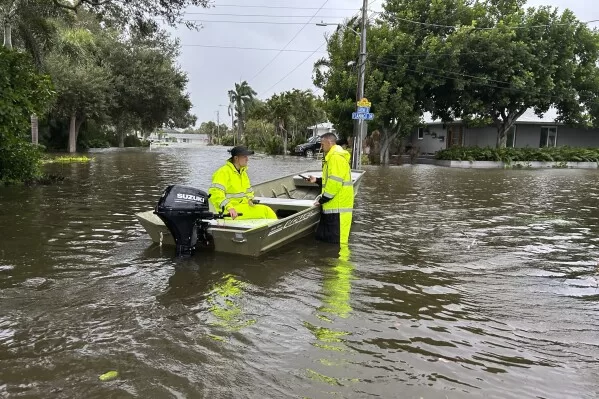Introduction: Hurricane Helene Impact
Hurricane Helene has left a devastating mark on the southeastern United States, claiming at least 64 lives and leaving nearly 3.5 million people without power. The storm made landfall late Thursday in Florida’s Big Bend region as a Category 4 hurricane, bringing with it winds of 140 mph and causing unprecedented flooding and destruction across several states.

The Scale of Destruction
In the aftermath of the hurricane, historic flooding has overwhelmed parts of the southern Appalachians, with first responders scrambling to assist communities in distress. Georgia’s governor, Brian Kemp, described the situation as looking “like a bomb went off,” emphasizing the severe impact on local areas.
Quentin Miller, the sheriff of Buncombe County, North Carolina, noted that many regions, including Asheville, remain cut off from communication due to downed cell towers, hindering rescue efforts and leaving families in uncertainty regarding the safety of their loved ones.
Government Response
In response to the crisis, President Joe Biden stated he was deeply saddened by the devastation and loss of life. He assured the public that FEMA is actively assessing the damage and coordinating relief efforts. Biden emphasized, “We’re not going to walk away. We’re not going to give up.”
Vice President Kamala Harris echoed this commitment, stating that federal personnel are on the ground providing support and ensuring that essential resources are available to affected communities.
Estimating the Cost of Damage
The combination of high winds, torrential rains, and subsequent flooding has resulted in estimated damages ranging between $95 billion and $110 billion, potentially marking Helene as one of the most expensive storms in U.S. history. The Associated Press has reported fatalities across multiple states, including a heartbreaking loss involving a mother and her one-month-old twins.
Personal Accounts of Resilience
In Steinhatchee, Florida, resident Janalea England shared her experiences, stating, “I’ve never seen so many people homeless as what I have right now.” In a show of community spirit, she has converted her commercial fish market into a donation site for those affected by the storm.
Power Outages and Ongoing Threats
As of midday Saturday, power outages were widespread, with over 1 million homes and businesses without electricity across states like South Carolina, Georgia, and North Carolina. Although Helene has weakened to a post-tropical cyclone, the threat of further rainfall and destruction lingers as it continues its path through the Tennessee Valley.
Historic Flooding in North Carolina
North Carolina is experiencing some of the worst flooding seen in a century, with Governor Roy Cooper labeling the situation as “catastrophic.” Communities, such as Spruce Pine, have received more than 2 feet (0.6 meters) of rain within days, prompting major road closures and isolating areas from necessary aid.
In Unicoi County, Tennessee, emergency responders conducted dramatic helicopter rescues from a hospital surrounded by floodwaters. Representative Diana Harshbarger reflected on the unprecedented nature of the storm’s damage in East Tennessee, saying, “Who would have thought a hurricane would do this much damage?”
International Context: Storm John in Mexico
At the same time, Tropical Storm John has caused significant flooding in Mexico, particularly in Acapulco, where at least 22 people have died. The resort city, still recovering from Hurricane Otis last year, faces new challenges as heavy rains trigger landslides and flooding.
The Role of Climate Change
Climate experts warn that global warming is intensifying the severity of storms like Helene. A recent study found that Atlantic storms have become deadlier as the planet warms, disproportionately affecting communities of color. The National Hurricane Center is currently monitoring additional storms, including Tropical Storm Joyce and Hurricane Isaac, indicating that challenges in storm preparedness and response continue.
Timeline of Key Events: Hurricane Helene
- September 26, 2024: Hurricane Helene forms in the Gulf of Mexico.
- September 28, 2024: Helene makes landfall in Florida’s Big Bend region as a Category 4 hurricane.
- September 28, 2024: Reports of significant flooding and destruction across southeastern states.
- September 29, 2024: Federal and state officials coordinate disaster response and recovery efforts.
This tragic event underscores the urgency of addressing climate change and enhancing infrastructure to mitigate the impacts of future storms. The stories of those affected will continue to drive recovery efforts as the nation responds to this disaster.
Conclusion
Hurricane Helene’s impact is far-reaching, as the southeastern U.S. faces the daunting task of recovery. The devastation serves as a reminder of the increasing severity of natural disasters in the face of climate change. As communities begin to rebuild, the resilience and solidarity displayed by affected individuals will be vital in overcoming the challenges ahead.
For Regular News and Updates Follow – Sentinel eGazette
FAQs
1. What caused Hurricane Helene to be so destructive?
Hurricane Helene’s intensity was primarily due to its classification as a Category 4 hurricane, combined with climate change, which has made storms more severe.
2. How can communities better prepare for future hurricanes?
Communities can prepare by investing in resilient infrastructure, improving early warning systems, and increasing public education about disaster preparedness.
3. What federal resources are available for hurricane recovery?
The Federal Emergency Management Agency (FEMA) provides resources such as financial aid, emergency assistance, and logistical support for recovery efforts.
4. How is climate change affecting hurricane patterns?
Climate change leads to warmer ocean temperatures, which can intensify hurricanes and increase their frequency, making them more unpredictable and dangerous.
5. What steps are governments taking to address climate change?
Governments are implementing policies aimed at reducing carbon emissions, investing in renewable energy sources, and promoting sustainability initiatives to combat climate change.